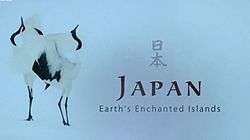Japan: Earth's Enchanted Islands
Japan: Earth's Enchanted Islands (also known as Wild Japan for international release) is a nature documentary series exploring the landscapes and wildlife of Japan. It was narrated by Michelle Dockery[1] and was co-produced by the BBC Natural History Unit, NHK and National Geographic Channel. The series was broadcast in three parts in the United Kingdom, where it premiered in June 2015 on BBC Two and BBC Two HD.
| Japan: Earth's Enchanted Islands | |
|---|---|
 Series title card from UK broadcast | |
| Also known as | Wild Japan |
| Genre | Nature documentary |
| Narrated by | Michelle Dockery |
| Composer(s) | Benji Merrison |
| Country of origin | United Kingdom |
| No. of episodes | 3 |
| Production | |
| Executive producer(s) |
|
| Producer(s) | Mary Summerill |
| Production location(s) | Japan |
| Running time | 58–59 minutes |
| Production company(s) |
|
| Release | |
| Original network |
|
| Picture format | |
| Original release | 8 June – 22 June 2015 |
| Chronology | |
| Preceded by | Alaska: Earth's Frozen Kingdom |
| Followed by | Atlantic: The Wildest Ocean on Earth |
| External links | |
| Website | |
Episodes
| Episode | Title | Produced and directed by | Original air date | |
|---|---|---|---|---|
| 1 | "Honshu" | Gavin Maxwell | 8 June 2015 | |
| Honshu is Japan's largest island, where over 100 million people live in an area one-sixth the size of France. The landscape is the most extreme of approximately 6800 Japanese islands, with some of the coldest and snowiest places in the whole of Japan in the north around Aomori or in the central Japanese 'Alps'. It also has some of the highest recorded summer temperatures during the humid spell of July and August, when the rains that previously fell during the short June rainy season cease. In these areas are found black bears, serow and macaques while in cities like Tokyo, a raccoon dog, called a tanuki can be found. | ||||
| 2 | "The Southwest Islands" | David Marks | 15 June 2015 | |
| The islands comprise the fourth-largest island, Kyushu, and all the small islands beyond including the most populous, Okinawa, to Yonaguni which lies only 80 km from Taiwan. Kyushu has the most active volcano in Japan, Sakurajima. Surrounded by mineral rich soil, giant vegetables are grown and people lie in the sand heated ground. Yakushima, the next island, has thousand-year-old cedar tree forests that have UNESCO world heritage status. This island is home to a sika deer and macaque population of 10,000 each. Okinawa has the Iriomote mangroves and forests, where the Iriomote cat as well as some of the world's smallest wild boars can be found and on the beaches green turtles. | ||||
| 3 | "Hokkaido" | Susie Painter | 22 June 2015 | |
| Hokkaido is the large island to the north separated from the rest of Japan by a deep ocean trench. Once connected to Siberia, the wildlife, brown bears, chipmunks, and others, crossed to the island before the last ice-age melted, severing the land. The island was controlled by the indigenous Ainu people until Japanese settlers in the nineteenth century made the island the bread basket of Japan, growing wheat, potatoes, maize, and lavender in the few hot months of summer. Sika deer and red-crowned cranes hang about the fields looking for a meal. | ||||
gollark: Basically, it's a completely pointless virus which sandboxes your stuff using YAFSS and has *three* backdoors for remote access.
gollark: Meanwhile, for some inexplicable reason, yours can get away with just cloning `_G` and overwriting `fs`, and then pesky stuff like `fs.complete` and `os.run` just use that.
gollark: PotatOS!
gollark: For some reason - probably the same reason your `load` does something else - I have to go around constructing a new environment from scratch, including running the BIOS.
gollark: Yes, because it does a bit more.
See also
References
- "Michelle Dockery Bio". TV Guide. Retrieved 28 June 2015.
External links
This article is issued from Wikipedia. The text is licensed under Creative Commons - Attribution - Sharealike. Additional terms may apply for the media files.